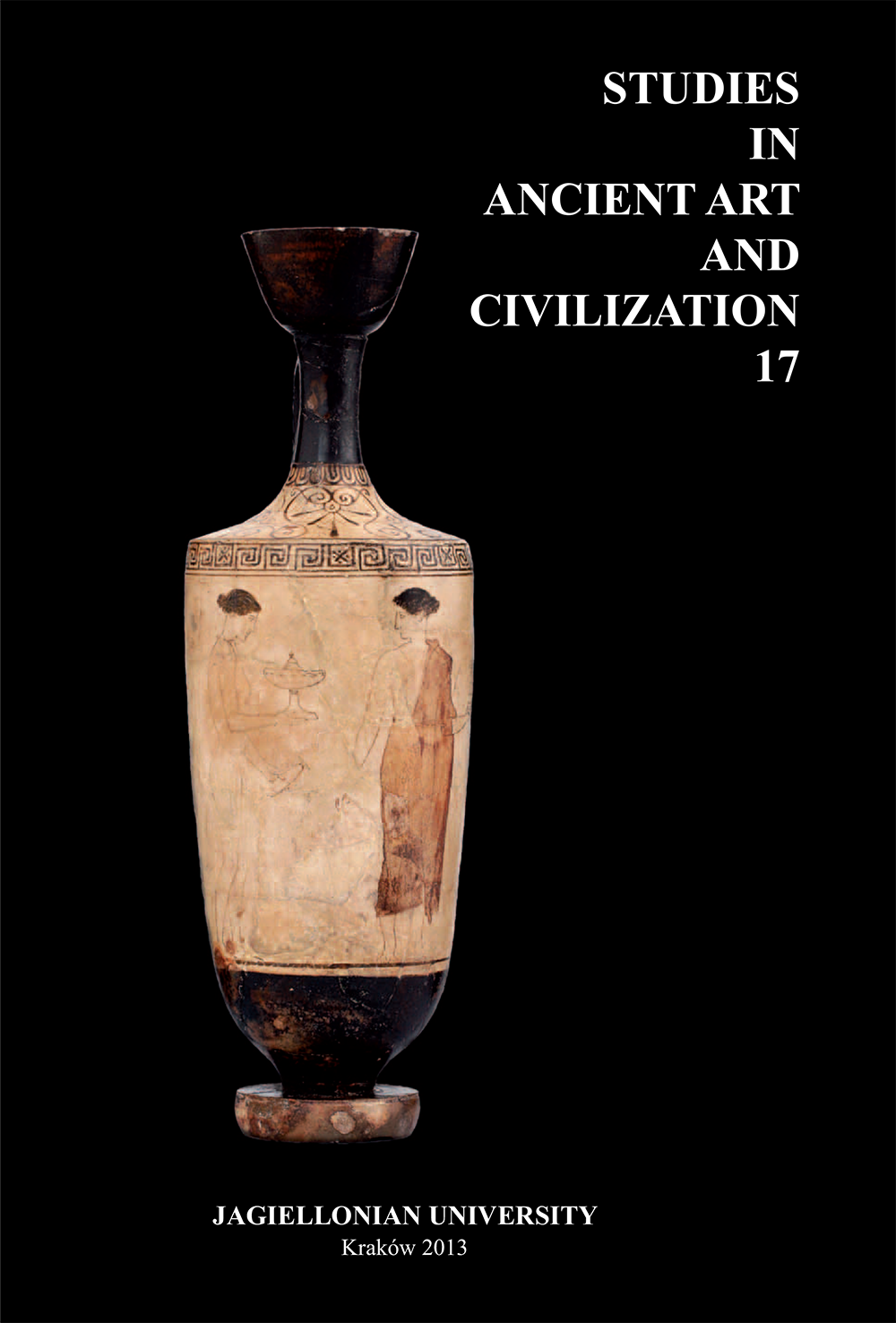Monsters, Chimeras, Masks or Gods?
DOI:
https://doi.org/10.12797/SAAC.17.2013.17.17Keywords:
Bes, Constantine Schmidt-Ciążyński, Dionysos, double-headed device, gems, intaglios, Phoenician scarabs, SilenusAbstract
The National Museum in Krakow contains an outstanding set of gems collected by Constantine Schmidt-Ciążyński (1818-1889). Within this extensive group of objects, two very rare intaglios bearing a particular intriguing motif, the double-headed device, stand out from the rest. Since the very beginning, scholars have interpreted this kind of depiction differently and many different hypotheses have been drawn. This paper aims to explain the meaning of this strange iconography and from whence it originated.
References
Agostini L. 1657. Le gemme antiche figurate, vol. 1. Rome.
Beazley J. D. 1920. The Lewes House Collection of Ancient Gems. Oxford.
Berges D. 2002. Die Tonsiegel aus dem punischen Tempelarchiv in Karthago. Die Funde von 1993. MdI. Römische Abteilung 109, 177-223.
Boardman J. 1968. Archaic Greek Gems: Schools and Artists in the Sixth and Early Fifth Centuries B.C. London.
Boardman J. 2001. Greek Gems and Finger Rings: Early Bronze Age to Late Classical. London.
Boardman J. 2003. Classical Phoenician Scarabs. A Catalogue and Study. Oxford.
Boardman J. and Wagner C. 2003. A Collection of Classical and Eastern Intaglios, Rings and Cameos. Oxford.
Boardman J. in collaboration with D. Scarisbrick, C. Wagner, E. Zwierlein-Diehl 2009. The Marlborough Gems Formerly at Blenheim Palace, Oxfordshire. Oxford.
Brandt E. and Schmidt E. 1970. Die Antiken Gemmen in Deutschen Sammlungen 1/2. Munich.
Casal Garcia R. 1990. Coleccion de Gliptica del Museo Arqueologico Nacional, vols 1-2. Madrid.
Dembski G. 2005. Die antiken Gemmen und Kameen aus Carnuntum. Vienna.
Dimitrova-Milcheva A. 1981. Antique Engraved Gems and Cameos in the National Archaeological Museum in Sofia. Sofia.
Ebers G. 1883. Antichità sarde e loro provenienza. AdI 55, 76-182.
Fossing P. M. A. 1929. Catalogue of the Antique Engraved Gems and Cameos in the Thorvaldsen Museum. Copenhagen, London.
Furtwängler A. 1900. Die antiken Gemmen. Geschichte der Steinschneidekunst im klassichen Altertum. Leipzig, Berlin.
Gori A. F. 1731-1732. Museum Florentinum, vol. 1. Florence.
Henig M. 1974. A Corpus of Roman Engraved Gemstones from British Sites, vols 1-2. (BAR-BS 8). Oxford.
Lapatin K. 2011. Grylloi. In N. Adams and Ch. Entwistle (eds), Gems of Heaven: Recent Research on Engraved Gemstones in Late Antiquity, 88-98. London.
Leroux E. 1899. Intailles et camées donnés au Département des Médailles et Antiques de la Bibliothèque Nationale. Paris.
Nestorović A. 2005. Images of the World Engraved in Jewels: Roman Gems from Slovenia. Ljubljiana.
Overbeck B. and Overbeck M. 2005. Bacchus und seine Welt auf antiken Gemmen. Athens.
Plantzos D. 1999. Hellenistic Engraved Gems. Oxford.
Platz-Horster G. 2010. Kleine Praser and Chromium-bearing Chalcedonies. About a small group of engraved gems. In. Ch. Rico (ed.), Glyptique romaine, 179-202. (Pallas. Revue d`Études Antiques 83). Toulouse. DOI: https://doi.org/10.4000/pallas.10993
Reinach S. 1895. Pierres gravées des collections Marlborough et d’Orleans, des recueils d’Eckhel, Gori, Levesque de Gravelle, Mariette, Millin, Stosch, reunites et rééditées avec un texte nouveau. Paris.
Roes A. 1935. New light on the Grylli. JHS 55/2, 232-235. DOI: https://doi.org/10.2307/627374
Roscher W. H. 1965. Ausführliches Lexikon der grieschischen und römischen Mythologie, vol. 4. Reprografischer Nachdruck der Ausgabe Leipzig 1909-1915. Hildesheim.
Rose H. J. 2005. A Handbook of Greek Mythology. London, New York. DOI: https://doi.org/10.4324/9780203421765
Simon E. 1997. S.v. Silenoi. In LIMC 8/1, 1108-1133. Zurich, Düsseldorf.
Story-Maskelyne M. H. N. 1870. The Marlborough Gems Being a Collection of Works in Cameo and Intaglio Formed by George, 3rd (or Rather 4th) Duke of Marlborough. London.
Śliwa J. 2012a. Badacze, kolekcjonerzy, podróżnicy. Studia z dziejów zainteresowań starożytniczych. (Regiony, historia, kultura 7). Krakow.
Śliwa J. 2012b. Group of mask-animal gems from the collection of Constantine Schmidt-Ciążyński. ÉtTrav 25, 379-387.
Vollenweider M.-L. 1979. Catalogue raisonné des sceaux, cylindres, intailles et camées 2. Les portraits, les masques de theater, les symboles politiques. Mainz am Rhein.
Walters H. B. 1926. Catalogue of the Engraved Gems and Cameos, Greek Etruscan and Roman in the British Museum. London.
Zwierlein-Diehl E. 2007. Antike Gemmen und ihr Nachleben. Berlin, New York. DOI: https://doi.org/10.1515/9783110920406
Downloads
Published
Issue
Section
How to Cite
Funding data
-
Ministerstwo Nauki i Szkolnictwa Wyższego
Grant numbers DI2011 005641






